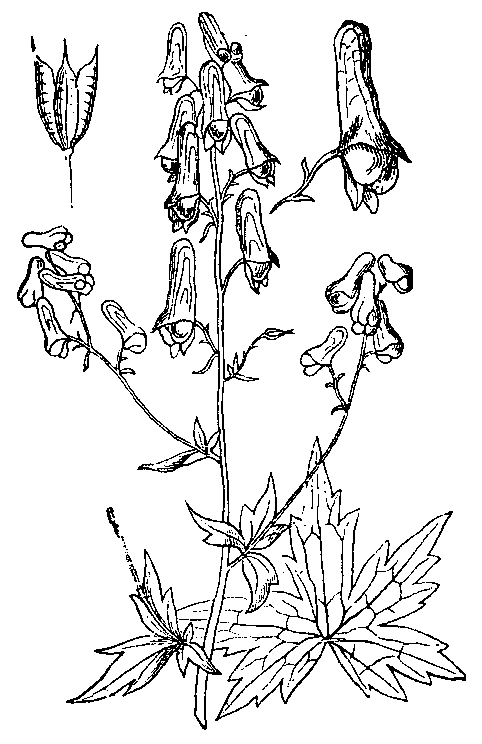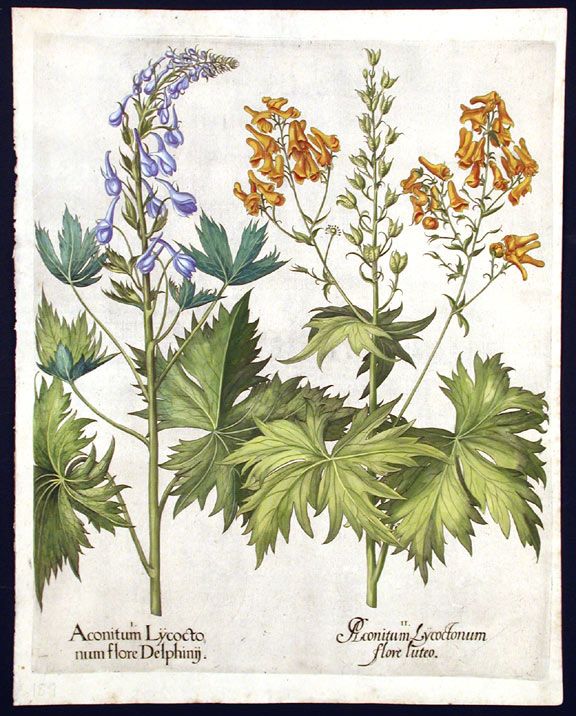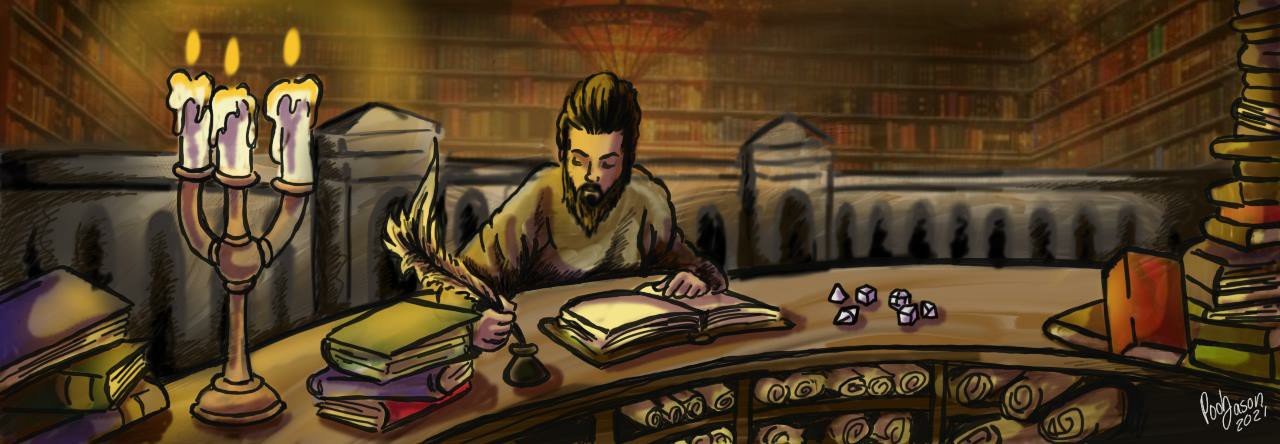The use of poisonous and medicinal plants has been a part of Dungeons & Dragons since the very beginning. The original 1974 D&D game included bunches of wolvesbane [sic] and belladonna in the basic equipment list. At a listed price of 10 gold pieces per bunch (the same price as a sword!), they were certainly expensive plants.
The 3LBBs do not describe how they were intended to be used, but if later descriptions found in sources like the AD&D Dungeon Master Guide and the Moldvay Basic Rulebook represent a continuum in terms of game usage, then the primary reason for including these two plants was to provide the characters with additional ways to combat lycanthropes and the adverse effects lycanthropy. In a way, wolfsbane and belladonna are functionally complimentary. If we set aside other medicinal uses noted in the later DMG, the plants were primarily used to either repel werewolves or, in the case of belladonna, potentially cure a character inflicted with lycanthropy (cf. DMG pp. 22, 220; and Moldvay p. B38).
This post will provide additional ways to use wolfsbane in a D&D game. I’ll occasionally refer to belladonna (aka nightshade), but I’ll devote a separate post to that particular plant later. Unlike my other posts on adderwort and mugwort, I’ll spend some time reflecting on how aspects of the OD&D rules appear to almost necessitate characters acquiring wolfsbane. In fact, if one is running an OD&D game using the original Wandering Monsters steps and tables as written, I believe wolfsbane is one of the most valuable protective items a character can purchase prior to undertaking an adventure (especially if it involves wilderness travel or exploration).
**All information in this post regarding the uses of various plants are for gaming purposes only. This information does not represent actual medical guidelines/recommendations.

Wolfsbane
Name: Wolfsbane (In Old English = thung = generic word for poison or a plant with little medicinal value)
Other Local Names: Monkshood, Mousebane, Woman’s bane (different names usually refer to different species of acotinum)
Latin(-derived) Names: aconitum (“aconite”)
Modern Species Name: aconitum lycotonum
Where Found: mountain meadows, forests, alpine forests, shaded areas
Medicinal Value: While wolfsbane has some medicinal value, it is considered very risky to use for medicinal purposes due to its highly toxic nature. For the well-trained willing to take the risks, wolfsbane can be used as an effective pain killer when properly diluted and carefully prepared.
Other Uses: Wolfsbane is primarily used as a poison that causes restrictive breathing that may lead to suffocation and cardiac arrest. Traditionally, it has been used by hunters and shepherds to poison meat that is then left as bait for wolves, hence the name wolfsbane or “wolf killer.” Wolfsbane is poisonous to ingest or touch; care must also be taken when handling the plant because one could be adversely affected by merely touching the leaves. Despite the name, the plant is equally poisonous for pests like mice and even humans.
Folklore claims that wolfsbane is one of the ingredients used to create a witches flying ointment (as is belladonna/nightshade). In a low-magic or no-magic setting, this might refer to an ointment that induces a kind of out-of-body experience, an idea possibly linked to earlier Germanic conceptions concerning the body, spiritual essence, and personhood. In a high-magic setting, wolfsbane might very well be a primary ingredient for an actual flying ointment, or perhaps a flying potion. Lastly, folklore (some from the modern era) suggests that wolfsbane will repel werewolves (“man-wolves”). Others tales claim that merely being exposed to wolfsbane during a full moon might cause one to become a werewolf.

Wolfsbane Uses in D&D
Pseudo-Historical / Magic-free Games
For all the various wolfsbane preparations that follow, Referees may want to consider calling for a saving throw vs. Poison whenever they perceive characters handling wolfsbane without proper care and caution.
Pain Relief Remedy: Drinking a highly diluted decoction of wolfsbane roots and leaves may:
- provide considerable pain relief to wounded/sick/diseased persons.
Since such a decoction can be potentially deadly if not prepared properly, Referees might call for a saving throw vs. Poison to survive. The roll could be modified positively or negatively based on who prepared the remedy, the constitution of the recipient, and other circumstantial factors. I believe player agency/choice coupled with known risks make for more fulfilling and meaningful games. However, if this seems too harsh for one’s game, then consider having the player’s character experience various hallucinogenic effects, in addition to the pain relief, should the saving roll fail.
Wolfsbane Bait: Combing a bunch of wolfsbane with raw meat or an animal carcass may:
- create a poisonous bait for wolves and other meat-eating predators (including monsters*). If the bait is consumed, the target creature(s) must save vs. Poison. Failure results in death. Depending on the Referee, success might still result in incapacitation due to sickness after 1d4 rounds.
* In OD&D, edible items have a 10% of distracting intelligent monsters from pursuit. This percentage is increased to 50% for semi-intelligent monsters, while non-intelligent monsters will be distracted 90% of the time by food. Dropping something like a ration or rabbit’s carcass mixed with wolfsbane could be an effective way to escape dangerous pursuit.
Poisonous Tincture: Drinking something spiked with a potent wolfsbane tincture may:
- poison and kill the victim within 1d6 minutes if a save vs. Poison is failed. Success could still result in the victim experiencing distressing respiratory symptoms, becoming violently sick, and/or experiencing various hallucinogenic effects for 2d20 hours.
Poisonous Paste: Applying a prepared paste of crushed wolfsbane root and leaves to the blades of edged weapons or arrowheads may:
- poison and kill the wounded victim within 1d6 hours if a save vs. Poison is failed. Success may still result in the victim experiencing distressing respiratory symptoms, becoming violently sick, and/or experiencing various hallucinogenic effects for 2d20 hours.
Rodent Bait/Repellent: Placing prepared wolfsbane bait around buildings like homes and barns may:
- poison and kill mice and rats that consume the bait. Ridding a dwelling or other structure of rodents might grant a character bonuses to future reaction checks since this service will be very beneficial to NPCs like farmers. Such a service may also result in some expression of gratitude, whether monetary or in the form of meals or lodging.
Low Magic/Fantasy Games
Flying Ointment Version I: Applying an expertly prepared ointment* to a person’s skin containing the correct ratios of wolfsbane, belladonna, hemlock and other herbal ingredients may:
- result in a type of floating “out-of-body” experience that temporarily grants the person the same benefits as the Clairvoyance and/or Clairaudience spells.
* Due to the number of simulant and narcotic plants involved in this recipe, Referee’s may want to rule that such ointments are only available from specialized NPCs like alchemists, apothecaries, and witches.
High Magic/Fantasy Games
The following remedies could significantly impact the niche role of the magic-user class (or cleric class) if open to all character classes. Referees are encouraged to consider this before implementing such remedies into their games. One suggestion is to limit the following fantastical remedies to certain specialized classes.
Flying Ointment Version II: Applying an expertly prepared ointment to a person’s skin containing the correct ratios of wolfsbane, belladonna, hemlock and other herbal ingredients may:
- temporarily grant the character the ability to fly, as per the Fly spell.
-or-
- temporarily grant the character the ability to levitate, as per the Levitate spell.
Against Werewolves: Dried bundles of wolfsbane may:
- repel werewolves, or any were-creatures. Characters that are carrying at least one bunch of wolfsbane will not be targeted for attack by were-creatures. Were-creatures will target other members of a party.
- cause were-creatures to flee if the character successfully attacks the were-creature with a bunch of wolfsbane (e.g., whether striking the creature while holding a bunch of wolfsbane or while it’s attached to something like the end of a staff). Characters are granted +1 to their attack rolls against were-creatures and successful attacks inflict 1d3 points of damage.
Call of the Wild: During the evening of a full moon, sleeping in an outdoor area where wolfsbane is growing may:
- cause the person to transform into a large wolf if a saving throw vs. Paralysis (or Poison) is failed. The person will flee the immediate area in a bloodthirsty rage. The effects last until morning. Upon waking, the victim will be disoriented and unable to recall the exact details of the previous evening. Whether the victim actually transforms/shapeshifts into a wolf will be left to the Referee to determine based on the context of the campaign. An alternative suggestion is that the victim experiences a hallucinogenic animal-like rage due to coming into contact with growing clusters of wolfsbane.
Smudging with Wolfsbane: Partaking in a pre-battle ritual that includes smudging with with a dried bundle of wolfsbane may:
- induce a berserker-like battle-lust that grants the character the same abilities as berserkers. In OD&D, this means that such individuals are fearless (i.e., no morale checks) and all attacks are granted a +2 bonus. Referees could add additional abilities in line with the particular ruleset they are using.
The Importance of Wolfsbane and Belladonna in OD&D
As briefly touched upon above in my reference to OD&D pursuit mechanics involving food, wolfsbane (and belladonna) provide characters with another resource that increases the odds of survival. Looking at the Wandering Monster tables found in the LBBs indicates that these plants would be very important to have during wilderness travel, if not essential at lower levels.
For example, there is always a chance to encounter some kind of lycanthrope when traveling in clear/open terrain, wooded terrain, river terrain, swamp terrain, and mountainous terrain. Even at first level. In OD&D using just the 3LBBs, only in desert and cities are players not going to randomly encounter a lycanthrope.
Note: Wererats were not among the lycanthropes listed in the 3LBBs (they show up later in the Greyhawk supplement), only were-wolves, boars, tigers, and bears. I, personally, would add wererats to my city random encounters if they were part of my campaign setting.
In clear, river, swamp, and mountain terrain there is a 1-in-8 chance of encountering a lycanthrope if a wandering encounter occurs (such random encounters have a 1-in-6 chance of occurring each day). This increases to a 2-in-8 chance for wandering encounters that occur in wooded terrain. In other words, should a wandering monster encounter occur while the players are traveling through wooded terrain, there will be a 25% chance that the wandering monsters will be lycanthropes.
This may seem like relatively small chances to some of you out there. But, if these were the odds for me potentially encountering a freaking pack of werebears every time I traveled through the woods . . .pssh, I would be draped with so many bundles of wolfsbane and belladonna that I would probably pass as a bush. That’s assuming that I could even summon the courage for such a journey.
And remember, lycanthropes are extremely dangerous in OD&D. Only silver or magical weapons/attacks affect them, and they always travel in packs. Packs! Additionally, anyone “seriously wounded” by a lycanthrope, such as losing around 50% hit points, is infected (no saving throw!). These poor victims will become a lycanthrope within 2-24 days unless a cleric performs a Cure Disease spell. Given the protective qualities of wolfsbane against lycanthropes, and the curative power of belladonna against lycanthropy, no adventurer with any sense and the necessary coin should be traveling without these plants.
Peace,
RC
If you liked this post, also see my posts on Adderwort and Mugwort. If you want to read other posts dealing with wilderness survival, foraging, and/or herbal remedies, then check out these two posts Herbal Lore & Remedies in D&D and Foraging, Hunting, & Wilderness Survival in B/X D&D.

Enjoy reading over all the different ways to utilize wolfsbane. Quite a few I didn’t even think about.
Thanks! I’m glad you enjoyed the post.